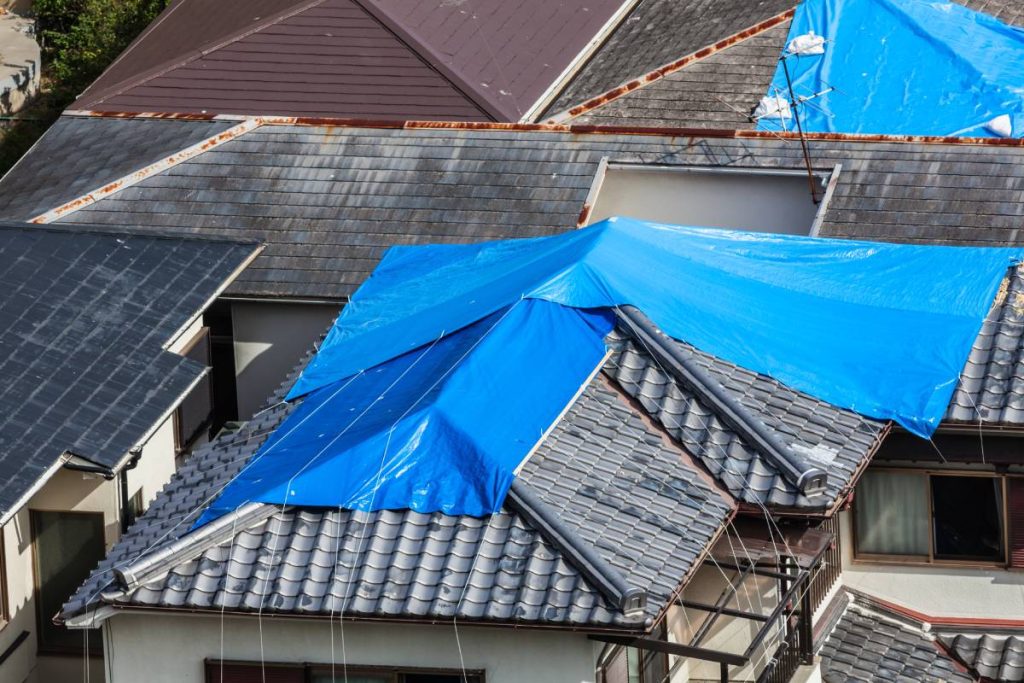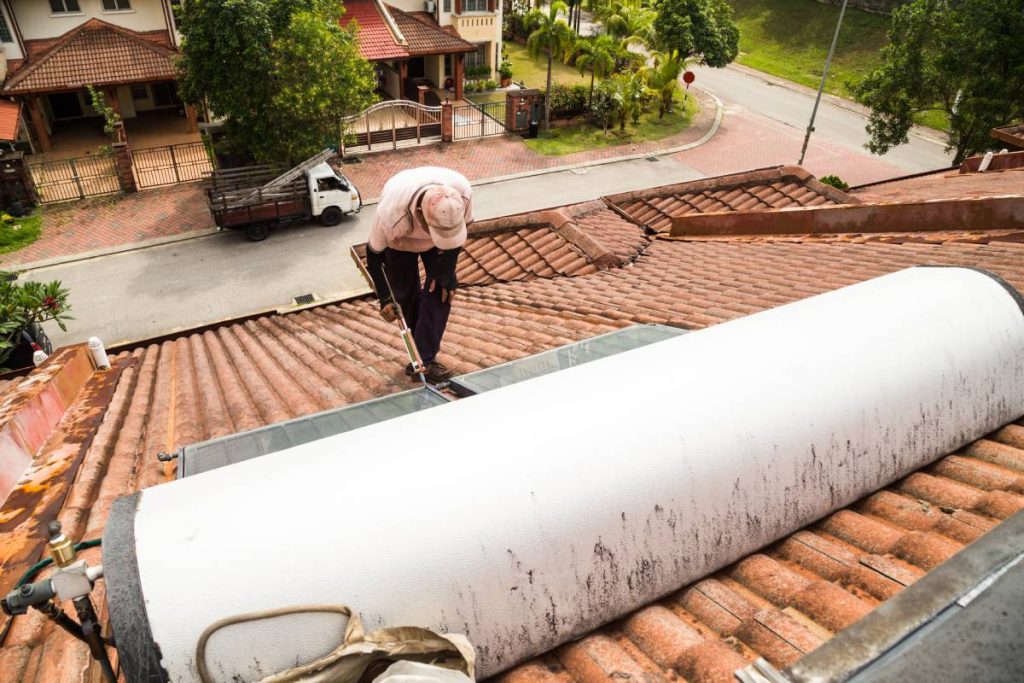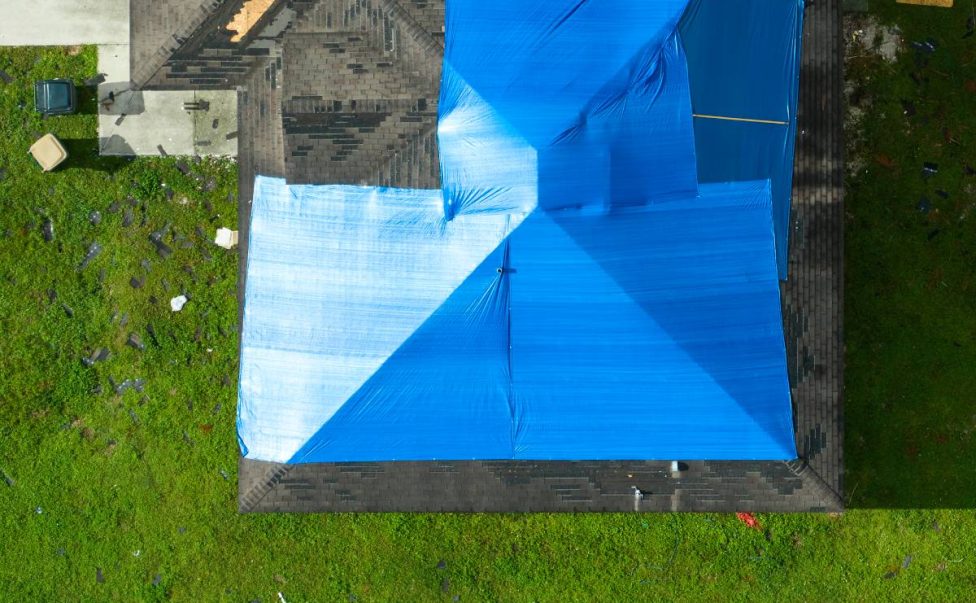What is a tarp on a roof? How much does it cost to tarp a roof in Australia?
Roofs are our homes’ unsung heroes, shielding us from the elements day in and day out. But what happens when our trusty protectors become compromised? Whether it’s due to a sudden storm, fallen debris, or simply the wear and tear of time, roof damage can be a homeowner’s nightmare.
In such moments of crisis, a simple yet effective solution emerges: the humble tarp. Like a knight’s shield in the face of adversity, a tarp provides temporary protection, keeping the elements at bay until permanent repairs can be made. But how long can a tarp truly hold the fort? What factors influence its effectiveness and lifespan? And how much does this lifesaving measure cost for homeowners Down Under?
Let’s dive into the world of tarps and figure out what’s what.
What is a tarp on a roof?
A tarp on a roof is like a superhero cape for your house. It’s a large piece of durable fabric, usually made of materials like polyethylene or canvas, that you lay over your roof to protect it from damage. Think of it as a shield against the elements, battling rain, wind, and sun to keep your home safe and dry.
Imagine this: Your roof springs a leak during a heavy rainstorm, water dripping into your home like an unwanted guest. You need a quick fix to stop the water from wreaking havoc inside. Enter the tarp. It’s your trusty sidekick, ready to leap into action and save the day.
But what exactly does a tarp do? Well, first and foremost, it provides a temporary barrier against water intrusion. When properly secured over a damaged area of your roof, it prevents rainwater from seeping into your home and causing further harm. It’s like a sturdy umbrella, but for your entire house.

Not only does a tarp keep water out, but it also shields your roof from other elements, like wind and debris. During a storm, strong winds can tear shingles off your roof, leaving it vulnerable to even more damage. A tarp acts as a protective shield, reducing the risk of further destruction until permanent repairs can be made.
Installing a tarp on your roof may sound simple, but it requires careful planning and proper technique to be effective. You need to secure the tarp tightly to prevent it from being blown away by strong winds. This often involves using ropes, bungee cords, or weights to hold it in place. Additionally, you must ensure that the tarp covers the damaged area completely, leaving no gaps for water to penetrate.
Now, you might be wondering, “How long can a tarp stay on a roof?” Well, that depends on several factors, such as the severity of the damage, the quality of the tarp, and the weather conditions. In ideal circumstances, a tarp can provide temporary protection for a few weeks or even months. However, it’s essential to monitor the tarp regularly and replace it if it shows signs of wear or damage.
While a tarp can be a lifesaver in emergencies, it’s essential to remember that it’s only a temporary solution. Eventually, you’ll need to repair or replace your roof to ensure long-term stability and protection. A tarp is like a bandage for your roof—it stops the bleeding temporarily, but you still need to see the doctor (or roofer) for proper treatment.
How long can you leave a tarp on a roof?
Leaving a tarp on a roof is like putting a temporary patch on a bicycle tyre—it’s a quick fix to stop the immediate problem, but it’s not a long-term solution. So, how long can you leave a tarp on a roof before it needs to be replaced or repaired? Let’s dive in and find out.
First things first, why would you need to put a tarp on your roof in the first place? Well, roofs can suffer damage from various sources, like storms, fallen branches, or even critters looking for a cosy home. When your roof springs a leak or sustains damage, a tarp can provide temporary protection until you can make permanent repairs.

But how long can you rely on that tarp to keep your roof safe and dry? The answer depends on a few factors:
- Severity of Damage: If your roof has minor damage, like a few missing shingles or a small leak, a tarp can typically hold up for a few weeks or even months. However, if the damage is extensive or the tarp is not properly secured, its lifespan may be shorter.
- Quality of Tarp: Not all tarps are created equal. Some are made of durable materials designed to withstand harsh weather conditions, while others are more lightweight and prone to tearing. Investing in a high-quality tarp can prolong its lifespan and provide better protection for your roof.
- Weather Conditions: Mother Nature can be unpredictable. If your area experiences frequent storms, high winds, or extreme temperatures, the lifespan of your tarp may be shortened. Harsh weather can weaken the fabric and cause it to degrade more quickly.
- Regular Maintenance: Just like any other part of your home, tarps require regular maintenance to ensure they remain effective. Inspect the tarp periodically for signs of wear or damage, and make any necessary repairs or replacements as soon as possible.
So, what happens if you leave a tarp on your roof for too long? Well, like any temporary solution, it’s not meant to last forever. Over time, the tarp may start to degrade, tear, or become dislodged, leaving your roof vulnerable to further damage. Additionally, prolonged exposure to the elements can cause moisture to become trapped underneath the tarp, leading to mould, mildew, or rot.
How much does it cost to tarp a roof in Australia?
Covering a roof with a tarp can cost between $200 and $1,300. Most homeowners spend around $650 or less. The price range varies because several factors influence the cost, such as the roof’s size, tarp quality, type, and whether emergency services are needed.
Tarping your roof shields your home from further damage when its structure or integrity is compromised due to a storm, fire, or accident. It’s a temporary fix until permanent repairs are made. This guide helps you estimate expenses for this project, considering factors like roof size, labour, and emergency services.
Average Cost to Tarp a Roof
- Average: $650
- Highest: $1,300
- Lowest: $200
Cost to Tarp a Roof by Square Foot
Typically, tarping a roof costs between $0.70 and $2 per square foot, covering materials and labour. Emergency services increase costs, ranging from $1 to $2.80 per square foot.
Tarp Size (in Square Feet) and Average Cost Range:
- 1,000 sq ft: $700 – $2,000
- 1,500 sq ft: $1,050 – $3,000
- 2,000 sq ft: $1,400 – $4,000
- 2,500 sq ft: $1,750 – $5,000

Breaking Down Roof-Tarp Costs
The cost of tarping a roof depends on various factors, including roof type and size, as well as the extent of damage.
Labour: Unless you can safely tarp the roof yourself, hiring a professional is necessary. Labour costs range from $50 to $100 per hour, with the job typically taking one to three hours. The duration depends heavily on factors like roof design, accessibility, size, and damage extent.
Emergency Services: Emergency tarping services come at a premium due to immediate response needs, often involving after-hours work. Expect to pay around $1 to $2.80 per square foot, approximately 30% more than standard services.
Duration of Tarping: Typically, roof tarping is temporary, lasting two to three months. For longer-term solutions, investing in more durable materials and installation methods is possible but will increase costs.
Roof Type: Different roof types incur varying costs. Pitched and complex roofs generally cost more to tarp due to increased time and labour. Asphalt shingles are cheaper to tarp over than tile roofs, which require more complex installation methods.
Accessibility: Roofs that are difficult to access, whether due to height, pitch, or obstacles, cost more to tarp. This is because they require additional time, labour, and sometimes safety measures and equipment.
Home Size: Since tarping costs are often based on square footage, larger homes incur higher expenses.
The extent of Damage: Severe damage increases tarping costs, as it may necessitate more labour and materials for proper tarping. In some cases, debris removal services, such as tree removal, may be required beforehand, further increasing costs.
Additional Cost Factors in Roof Tarping
When tarping a roof, homeowners often require extra services before or after, leading to increased expenses.
Roof Leak Repair: Since roofs are often tarped due to leaks, it’s wise to budget for repairs. Costs vary from $350 for minor leaks to over $1,700 for major ones.
Full Roof Replacement: Severe damage may necessitate a complete roof replacement. Costs range from $6,700 to $80,000, with the average around $11,500. Factors such as roof size, shape, type, and material heavily influence these costs.
Roof Flashing Replacement: Flashing, which diverts water away from vulnerable areas like chimneys and skylights, may need replacement. Prices typically start at $400 and can go up to $1,600 for complex jobs, with an average cost of around $1,000.
Tarping a roof: DIY or professional?
Homeowners who are handy and comfortable with heights might consider tarping their roofs themselves to save money. However, this task can be risky, especially on steep or complex roofs. Additionally, if your roof is severely damaged, its structure and stability could be compromised, which may not be obvious at first glance. Therefore, if you have any doubts about your safety or capability to tarp the roof, it’s best to hire a professional.
Please note that all average figures mentioned were accurate at the time of publication and may have since changed.


